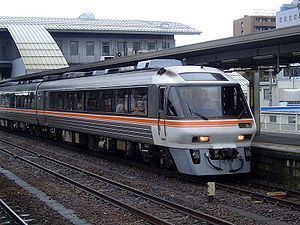Native name 高山本線 Operator(s) JR Central, JR West Electrification Not electrified | Stations 45 Track gauge 1,067 mm (3 ft 6 in) Locale Japan | |
 | ||
Line length 225.8 kilometres (140.3 mi) | ||
Our journey begins takayama main line
The Takayama Main Line (高山本線, Takayama Honsen) is a Japanese railway line between Gifu Station in Gifu and Toyama Station in Toyama, operated by Central Japan Railway Company (JR Central) and West Japan Railway Company (JR West). The line directly links the Chūkyō Metropolitan Area (metropolitan Nagoya) and Hokuriku region in a shorter distance, but with a longer travel time, than by using the combination of the Tōkaidō Shinkansen and Hokuriku Main Line. Now the line primarily functions as a way to access the scenic areas of Hida (ancient Hida Province), in the rugged mountains of northern Gifu Prefecture, such as Gero onsen (hot spring), Takayama, Shirakawa-gō, and the Kiso River. The first section of the line, between Gifu and Kagamigahara, opened in 1920 (1920). The whole line was completed in 1934.
Contents
- Our journey begins takayama main line
- Jr jr takayama main line from hida furukawa to hida kokufu 2015 3 14
- Basic data
- Services
- Hisuiky
- Washibara
- Fukurai
- Shgano
- JR Central
- JR West
- Former rolling stock
- History
- Former connecting lines
- References
Jr jr takayama main line from hida furukawa to hida kokufu 2015 3 14
Basic data
Services
The Hida limited express train operates between Nagoya and Takayama, Hida-Furukawa, and Toyama, with ten return services a day, and between Ōsaka and Takayama with one return service a day.
The line is generally divided to three parts for local services: between Gifu and Takayama; between Takayama and Inotani; and between Inotani and Toyama. There are roughly two trains per one hour between Gifu and Mino-Ōta, while there is no local train for four hours between Gero and Takayama.
Hisuikyō
In Hichisō, Gifu. (Coordinates: 35°32′43″N 137°08′39″E )
Washibara
In Shirakawa, Gifu. (Coordinates: 35°36′06″N 137°10′24″E )
Fukurai
In Gero, Gifu. (Coordinates: 35°40′51″N 137°10′00″E )
Shōgano
In Gero, Gifu. (Coordinates: 35°47′42″N 137°15′13″E )
JR Central
JR West
Former rolling stock
From the start of the March 2015 timetable revision, JR Central KiHa 25 diesel multiple unit (DMU) trains displaced from the Taketoyo Line were phased in on Takayama Line services, with the last remaining KiHa 40 series DMU trains withdrawn from the line on 30 June 2015.
History
The Gifu to Mino-Ota section opened in 1920, and the line was then extended in sections, opening to Gero in 1930 and Hida-Osaka in 1933. At the northern end the first section from Toyama opened in 1927, reached Inotani in 1930 and Takayama and Hida-Osaka in 1934, completing the line.
CTC signalling was commissioned in 1968, and in 1980, a ground-breaking ceremony was held at Takayama for the proposed electrification of the line, but the program was cancelled later that year before any significant work was undertaken. Freight services ceased on the line in 2007.
Between 2004 and September 8, 2007, the section between Tsunogawa Station and Inotani Station was closed due to flood damage from Typhoon Tokage.
